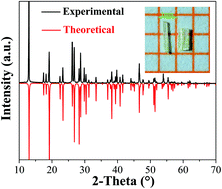Li2CdSiS4, a promising IR NLO material with a balanced Eg and SHG response originating from the effect of Cd with d10 configuration†
Abstract
Infrared (IR) nonlinear optical (NLO) materials are of great importance in laser technology, which could be applied in many civil and military fields. However, the low laser damage threshold and two-photon absorption, caused by the small bandgap, have hindered the applications of commercial IR NLO materials. In this work, Li2CdSiS4, with a wide bandgap (3.76 eV) and a moderate second-harmonic generation (SHG) response (1 × AgGaS2) was successfully designed and fabricated by a high temperature flux method in vacuum and sealed quartz tubes. The compound with a wurtz-stannite structure type was constructed with hexagonal close packing tetrahedra and it meets the requirements of optimal IR NLO material properties. Theoretical results show that Li2CdSiS4 has an indirect bandgap, and the bandgap is determined by the S 3p and Si 3p orbitals, not by the massive Cd element, which enables Li2CdSiS4 to have a wider bandgap than those of other Cd-obtained chalcogenides. In addition, the SHG response originates mainly from the S2− and Cd2+ of CdS4 tetrahedra while the contributions of Li and Si in this compound are ignorable. All the above information indicates that Li2CdSiS4 is a promising NLO material in the IR field and Cd is a good choice for designing new IR NLO materials.



 Please wait while we load your content...
Please wait while we load your content...